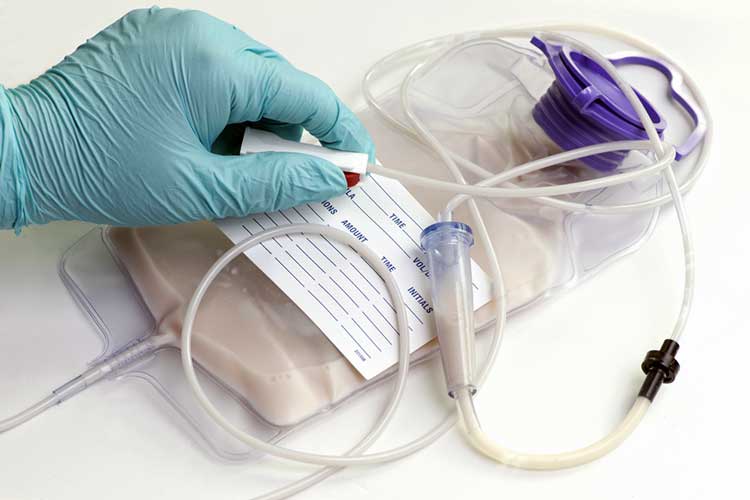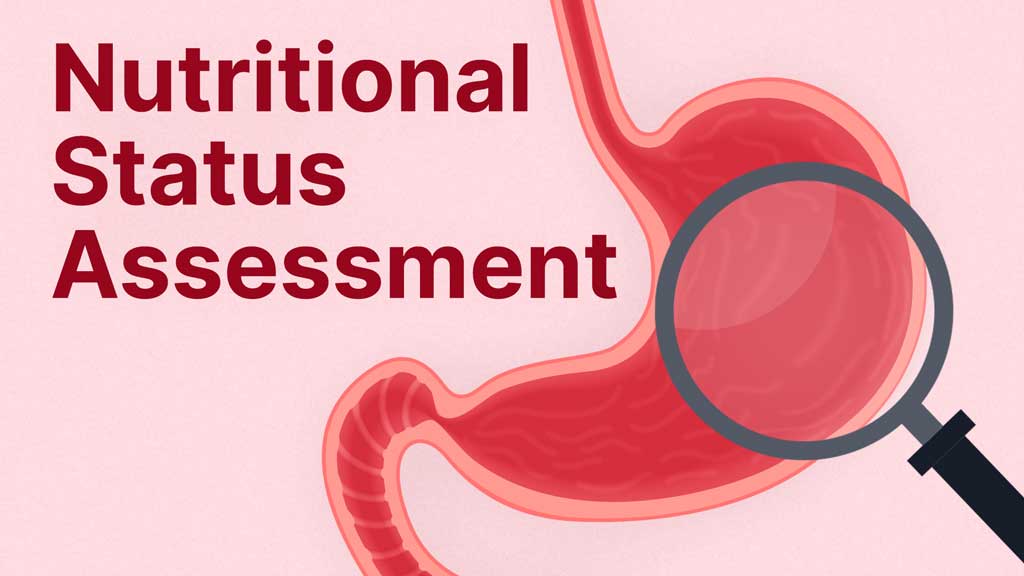Malnutrition is very common in critically ill patients as their nutrition status declines.
In fact, malnutrition is estimated to affect between 38% and 78% of patients in the intensive care unit (Narayan et al. 2020).
Malnutrition is associated with impaired immunologic function, and malnourished patients have poorer outcomes after medical treatment or surgery (Kesari & Noel 2023).
Therefore, nutrition should be assessed as soon as possible, preferably upon admission, with ongoing monitoring for all critically ill patients to ensure individual needs are identified and catered for to improve outcomes (Siobal et al. 2021).
The Importance of Assessing Nutritional Status
The aim of assessing a patient’s nutritional status is to:
- Evaluate pre-existing hydration and nutritional conditions
- Identify any hydration and nutrition-related complications that could affect the outcome
- Determine the patient’s nutritional requirements
- Maintain the optimum level of intake and promote adequate utilisation of hydration and food to promote growth, healing and recovery.
(Kesari & Noel 2023; Siobal et al. 2021)
Factors That Affect Nutritional Status in Critically Ill Patients
Factors that can affect nutritional status in critically ill patients include:
- Being severely underweight (less than 80% of ideal body weight) or overweight (more than 120% of ideal body weight)
- Loss of over 10% of body weight over the past three months
- Alcohol or substance abuse
- Being nil by mouth for more than five days
- Increased losses of nutrients
- Malabsorption
- Short bowel syndrome
- Fistulae
- Wounds, burns or draining abscesses
- Renal dialysis
- Higher nutrient requirements
- Trauma
- Sepsis
- Medications with anti-nutrient properties.
(Narayan et al. 2020)
Assessing a Critically Ill Patient’s Nutritional Status
All patients should undergo nutritional screening upon admission to a hospital or healthcare setting (NICE 2017). You should follow your local policies and protocols to identify patients at risk of malnutrition and dehydration.
Steps for appropriate management include:
1. Screening
Screening is used to identify patients who are ‘at risk’.
One screening tool commonly used in hospitals, communities, and other healthcare settings is the Malnutrition Universal Screening Tool (MUST). This tool identifies adults who are malnourished, at risk of malnutrition, or obese. It includes management guidelines that can be used to develop a care plan (BAPEN 2015).
2. Assessment
A full examination of nutritional, metabolic and functional variables should be conducted, and consideration should be paid to patient history, current medications, laboratory results, ability to swallow and bowel function (Kesari & Noel 2023).
The assessment should provide information leading to an appropriate care plan.
3. Monitoring and Outcome
The effectiveness of the nutritional intervention should regularly be monitored, leading to adjustments in treatment as necessary throughout the patient’s stay.
4. Communication
When the patient is transferred to another health professional, the screening and assessment results and the developed nutritional care plan should be communicated to them.
Modes of Feeding in Critically Ill Patients
Oral nutrition is generally considered the first-line method, but patients who cannot tolerate oral feeding can be fed enterally or parenterally. The route used will depend on:
- Whether the patient has a functioning gastrointestinal tract
- Which route is appropriate based on the patient’s condition
- The length of time that feeding will be required for.
(ASPEN 2018; Siobal et al. 2021)

Enteral Feeding
Read: Caring for Enteral Tubes
Enteral feeding involves administering liquid feed via a tube placed in the patient’s stomach, duodenum, or jejunum. It is the route of choice for critically ill patients who cannot intake orally. This method is used if a patient has a functional and accessible GI tract (NICE 2017).
Routes of Enteral Feeding
- Nasogastric: A tube through the nose into the stomach
- Nasoduodenal: a tube through the nose into the duodenum
- Nasojejunal: a tube through the nose into the jejunum
- Percutaneous endoscopic gastrostomy (PEG): A tube placed directly into the stomach through the skin of the abdomen. PEG tubes should be considered when enteral feeding is necessary for four weeks or more.
(Marengo & Dix 2023; NICE 2017)
Parenteral Nutrition
Parenteral nutrition involves the intravenous infusion of nutrients. It’s administrated via a single dedicated lumen either via a peripheral inserted central catheter (PICC) line, via central venous access or through an implanted port (Hamdan & Puckett 2023).
This route is used when oral and/or enteral nutrition is unable to fully meet the patient’s nutritional requirements, or when enteral nutrition is contraindicated (Hamdan & Puckett 2023).
Conclusion
Nutritional status should be assessed and regularly monitored in all critically ill patients. The method of nutritional support should also be closely monitored, in particular, the patient’s tolerance of it.
Test Your Knowledge
Question 1 of 3
Which feeding method should be the first-line approach if the patient can tolerate it?
Topics
Further your knowledge
 Free
Free Free
Free Free
Free Free
FreeReferences
- American Society for Parenteral and Enteral Nutrition 2018, Enteral Nutrition Care Pathway for Critically-Ill Adult Patients, ASPEN, viewed 10 October 2024, https://www.nutritioncare.org/Guidelines_and_Clinical_Resources/EN_Pathway/Enteral_Nutrition_Care_Pathway_for_Critically-Ill_Adult_Patients/
- British Association for Parenteral and Enteral Nutrition 2015, ‘Malnutrition Universal Screening Tool’, BAPEN, viewed 10 October 2024, https://www.bapen.org.uk/pdfs/must/must_full.pdf
- Hamdan, M & Puckett, Y 2023, ‘Total Parenteral Nutrition’, StatPearls, viewed 10 October, https://www.ncbi.nlm.nih.gov/books/NBK559036/
- Kesari, A & Noel, JY 2023, ‘Nutritional Assessment’, StatPearls, viewed 10 October 2024, https://www.ncbi.nlm.nih.gov/books/NBK580496/
- Marengo, K & Dix, M 2023, ‘Enteral Feeding: How It Works and When It’s Used’, Healthline, 13 July, viewed 10 October 2024, https://www.healthline.com/health/enteral-feeding
- Narayan, SK, Gudivada, KK & Krishna, B 2020, ‘Assessment of Nutritional Status in the Critically Ill’, Indian J Crit Care Med., vol. 24, suppl. 4, viewed 10 October 2024, https://www.ncbi.nlm.nih.gov/pmc/articles/PMC7724950/
- National Institute for Health and Care Excellence 2017, Nutrition Support for Adults: Oral Nutrition Support, Enteral Tube Feeding and Parenteral Nutrition, NICE, viewed 10 October 2024, https://www.nice.org.uk/guidance/cg32
- Siobal, MS, Baltz, JE & Wright, J 2021, A Guide to the Nutritional Assessment and Treatment of the Critically Ill Patient, 2nd edn, American Association for Respiratory Care, viewed 10 October 2024, https://www.aarc.org/wp-content/uploads/2014/11/nutrition_guide.pdf
- WA Country Health Service 2020, Enteral Tubes and Feeding - Adults Clinical Practice Standard, Government of Western Australia, viewed 10 October 2024, https://www.wacountry.health.wa.gov.au/~/media/WACHS/Documents/About-us/Policies/Enteral-Tubes-and-Feeding---Adults-Clinical-Practice-Standard.pdf?thn=0
 New
New 
